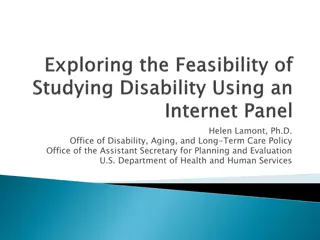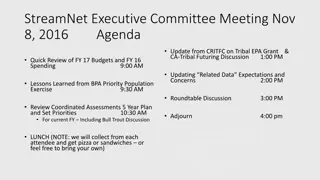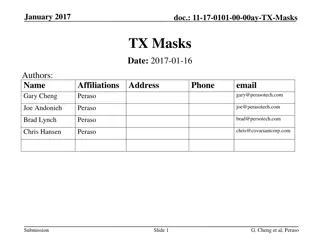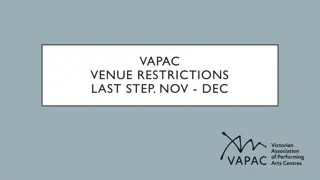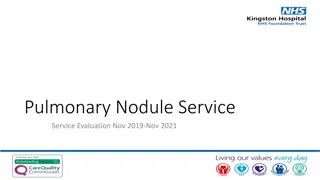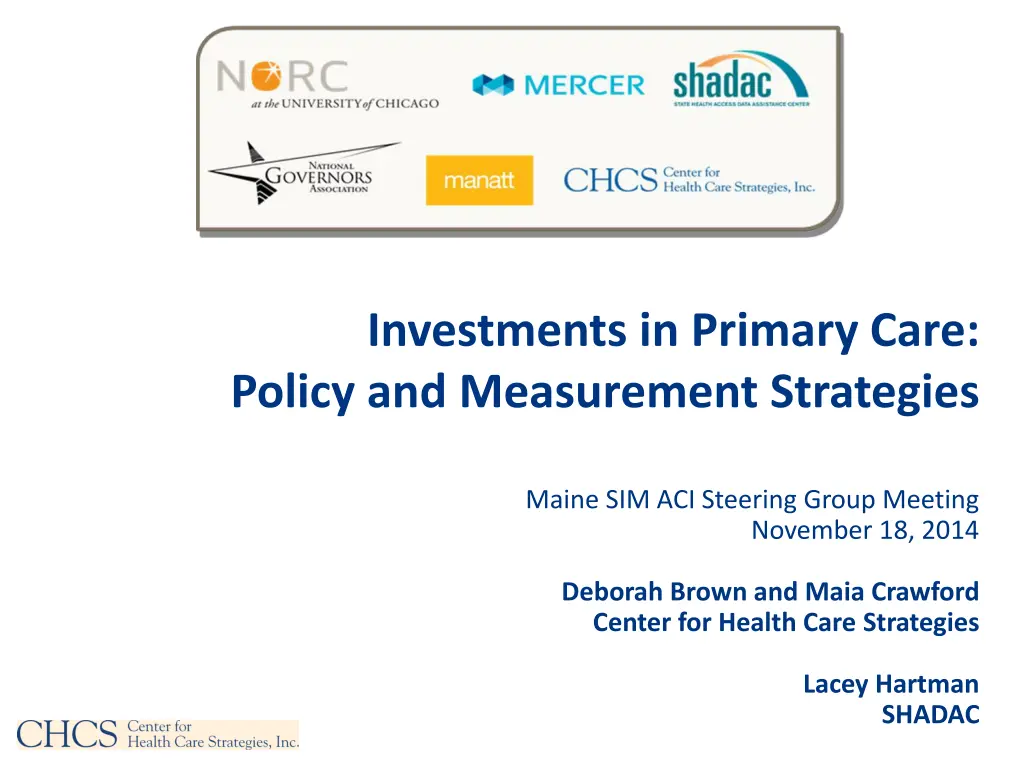
Investments in Primary Care Policy and Measurement Strategies
Learn about policy and measurement strategies for investments in primary care discussed at the Maine SIM ACI Steering Group Meeting in 2014. Topics include payment reform, increasing health payments for primary care, and options for primary care payment reform.
Download Presentation

Please find below an Image/Link to download the presentation.
The content on the website is provided AS IS for your information and personal use only. It may not be sold, licensed, or shared on other websites without obtaining consent from the author. If you encounter any issues during the download, it is possible that the publisher has removed the file from their server.
You are allowed to download the files provided on this website for personal or commercial use, subject to the condition that they are used lawfully. All files are the property of their respective owners.
The content on the website is provided AS IS for your information and personal use only. It may not be sold, licensed, or shared on other websites without obtaining consent from the author.
E N D
Presentation Transcript
Investments in Primary Care: Policy and Measurement Strategies Maine SIM ACI Steering Group Meeting November 18, 2014 Deborah Brown and Maia Crawford Center for Health Care Strategies Lacey Hartman SHADAC
NORC SIM TA Team Deborah Brown, Senior Program Officer, Center for Health Care Strategies Maia Crawford, Program Officer, Center for Health Care Strategies Lacey Hartman, Senior Research Fellow, SHADAC, University of Minnesota 2
Agenda I. II. Policy-related questions and discussion III. SHADAC: Measuring investments in primary care IV. Measurement questions and discussion CHCS: Policy options for reforming primary care 3
Presentation Findings Much of the information in this presentation is drawn from a SIM technical assistance policy brief entitled Multi-Payer Investments in Primary Care: Policy and Measurement Strategies 4
Payment Reform in Primary Care: Considerations for Maine Maine SIM ACI Steering Group Meeting November 18, 2014 Deborah Brown and Maia Crawford Center for Health Care Strategies www.chcs.org
Primary Care Payment Reform Options 1. Increase the percentage of health payments spent on primary care Tie PCP bump funds to payment reform Increase primary care rates based on medical home recognition Use pay-for-performance incentives Institute a comprehensive primary care payment Employ shared savings methodologies Combine patient-centered medical home (PCMH) with episodes of care 2. 3. 4. 5. 6. 7. 6
Increase the Percentage of Health Payments Spent on Primary Care Encourage health plans to gradually increase the proportion of total payments made to primary care services. Example: Rhode Island required commercial insurers to increase the share of total medical payments made to primary care by one percentage point per year from 2010 to 2014. 7
Tie PCP Bump Funds to Payment Reform Maine is one of 15 states currently choosing to partially or fully continue the Medicaid primary care rate increase in SFY 2015. The higher primary care rate could be implemented using a value-based payment method or used to transition PCPs to new payment methodologies. The State could also set criteria for providers to receive the enhanced payment. 8
Increase Primary Care Rates Based on Medical Home Recognition Reward primary care practices for increasing their levels of medical home-ness or for meeting other primary care- related goals. Examples: New York, Oklahoma, Nebraska,and Maryland tier medical home payments, rewarding practices that achieve higher levels of recognition with higher per-member per-month (PMPM) payments. Colorado increased evaluation and management codes for primary care visits to 90 percent of the Medicare rates. Practices receive a significantly higher bump for Medicaid preventive visits if they meet certain medical home criteria. 9
Use Pay for Performance Incentives Establish a P4P program to reward providers with a supplemental payment for meeting primary care targets. Examples: In Rhode Island s multi-payer medical home program, the PMPM payment increases or decreases based on achievement of performance targets related to utilization, quality and member satisfaction, and process improvement. ConnecticutMedicaid s PCMH program provides improvement payments and incentive payments for practices in the top 10 percent for performance. 10
Employ Shared Savings Methodologies Implement a shared savings component within medical homes or the broader primary care system, with accrued savings awarded based on primary care performance and reinvested in primary care infrastructure and staff. Examples: InMaryland s Multi-Payer PCMH Program, primary care practices can earn a percentage of the savings they generate through improved care and better patient outcomes. Beginning in 2015, Arkansas PCMH practices are eligible for shared savings if the practice: (1) completes all practice support activities and meets a majority of practice support metrics; and (2) meets 2/3 or more of quality metrics. 11
Institute a Comprehensive Primary Care Payment Offer practices an all-inclusive PMPM payment for clinical services and other medical home activities. Example: Under the Primary Care Payment Reform Initiative, Massachusetts Medicaid pays practices a Comprehensive Primary Care Payment, a risk-adjusted PMPM payment for defined primary care and behavioral health services. 12
Combine PCMH with Episodes of Care Two-pronged approach to payment reform: PCMH and episodes of care Examples: Arkansas has two PCMH initiatives (multi-payer and Medicaid), each with a PMPM care coordination fee and shared savings component. The state also established a retrospective, episode-based model in which payments are made to Principle Accountable Providers. Some episodes have primary care components (asthma, COPD, ADHD). Similar models in Tennessee and Ohio 13
Measuring Investments in Primary Care November 18, 2014 Lacey Hartman Sr. Research Fellow
Click to edit Master title style Measuring Investments in Primary Care Definitions: what counts as primary care? Target setting: how much should be spent on primary care? Tracking reinvestments: how is the money being spent? State examples RI, VT, OR Click to edit Master text styles Second level Third level Fourth level Fifth level 15
Click to edit Master title style Rhode Island: Policy Context 2010 legislation required insurers to increase share of total medical payments on primary care by 1 percentage point annually. increase share of PC $ that are non-FFS by 5 Click to edit Master text styles Second level Third level Fourth level Fifth level percentage points annually Cannot increase premiums or total medical expenditures Insurers file reports each quarter with relevant information 16
Click to edit Master title style Rhode Island: Primary Care Practices Click to edit Master text styles Second level Third level Fourth level Fifth level Family Practice Internal Medicine Pediatrics Specialists who are paid for primary care services on a primary care fee schedule Includes MDs, Dos, NPs, and PAs who have been identified as a usual source of care by an insured Limited by practice type 17
Click to edit Master title style Rhode Island: Insurer $ to Primary Care Practices Click to edit Master text styles Second level Third level Fourth level Fifth level Infrastructure supports for PCMH transformation and integration with behavioral health and community based services HIT Workforce: training and loan forgiveness Payments for services (FFS & capitation) Incentive payments (P4P, shared savings, etc.) 18
Click to edit Master title style Rhode Island: Results Click to edit Master text styles Second level Third level Fourth level Fifth level non-FFS investments (PCMH, EHRs, provider incentives for care coordination) Public reporting for total market and by company Targets will be readjusted in future years Primary care spending rose by 37% between 2008 and 2012 34% of $65 million in PC spending in 2014 went to Source: Commercial Insurer Primary Care Spending, Presentation to Health Insurance Advisory Council, January 21, 2014 19
Click to edit Master title style Vermont: Primary Care Service Areas (PCSAs) 2010 study to track utilization and expenditure flows for primary care Primary care providers included family medicine, internal medicine, pediatrics, registered nurses, and physician assistants* Primary care visits were defined with Evaluation & Management codes for office visits, consultations, nursing care, home services, preventive medical visits, counseling, and newborn care * *Full lists of relevant codes are available Click to edit Master text styles Second level Third level Fourth level Fifth level 20
Click to edit Master title style Oregon Click to edit Master text styles Second level Third level Fourth level Fifth level Primary care working definition: home and office visits, well-baby exams, physical exams, and preventive care. Milliman s Health Cost Guidelines Ongoing stakeholder work to refine definition Tracks PMPM primary care spending as part of quarterly health policy dashboard Report separately for commercial, Medicaid MC, and Medicare Advantage 21
Click to edit Master title style Considerations for Measurement In Maine Developing the baseline: building consensus on PC $ definition and appropriate data sources Targets/benchmarks Reporting Frequency Breakdowns (overall market, by payer, practice, etc.) Tracking reinvestments Complementary performance measures (draw on existing reporting efforts) Click to edit Master text styles Second level Third level Fourth level Fifth level 22








